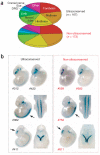Ultraconservation identifies a small subset of extremely constrained developmental enhancers
- PMID: 18176564
- PMCID: PMC2647775
- DOI: 10.1038/ng.2007.55
Ultraconservation identifies a small subset of extremely constrained developmental enhancers
Abstract
Extended perfect human-rodent sequence identity of at least 200 base pairs (ultraconservation) is potentially indicative of evolutionary or functional uniqueness. We used a transgenic mouse assay to compare the embryonic enhancer activity of 231 noncoding ultraconserved human genome regions with that of 206 extremely conserved regions lacking ultraconservation. Developmental enhancers were equally prevalent in both populations, suggesting instead that ultraconservation identifies a small, functionally indistinct subset of similarly constrained cis-regulatory elements.
Figures


Similar articles
-
In vivo enhancer analysis of human conserved non-coding sequences.Nature. 2006 Nov 23;444(7118):499-502. doi: 10.1038/nature05295. Epub 2006 Nov 5. Nature. 2006. PMID: 17086198
-
DNaseI hypersensitivity and ultraconservation reveal novel, interdependent long-range enhancers at the complex Pax6 cis-regulatory region.PLoS One. 2011;6(12):e28616. doi: 10.1371/journal.pone.0028616. Epub 2011 Dec 29. PLoS One. 2011. PMID: 22220192 Free PMC article.
-
Ultraconserved enhancer function does not require perfect sequence conservation.Nat Genet. 2021 Apr;53(4):521-528. doi: 10.1038/s41588-021-00812-3. Epub 2021 Mar 29. Nat Genet. 2021. PMID: 33782603 Free PMC article.
-
Cis-regulatory elements: molecular mechanisms and evolutionary processes underlying divergence.Nat Rev Genet. 2011 Dec 6;13(1):59-69. doi: 10.1038/nrg3095. Nat Rev Genet. 2011. PMID: 22143240 Review.
-
Comparative genomics of gene regulation-conservation and divergence of cis-regulatory information.Curr Opin Genet Dev. 2009 Dec;19(6):565-70. doi: 10.1016/j.gde.2009.10.006. Epub 2009 Nov 11. Curr Opin Genet Dev. 2009. PMID: 19913403 Review.
Cited by
-
Intersectional Cre driver lines generated using split-intein mediated split-Cre reconstitution.Sci Rep. 2012;2:497. doi: 10.1038/srep00497. Epub 2012 Jul 6. Sci Rep. 2012. PMID: 22773946 Free PMC article.
-
Ultraconserved Non-coding DNA Within Diptera and Hymenoptera.G3 (Bethesda). 2020 Sep 2;10(9):3015-3024. doi: 10.1534/g3.120.401502. G3 (Bethesda). 2020. PMID: 32601058 Free PMC article.
-
Algorithms for locating extremely conserved elements in multiple sequence alignments.BMC Bioinformatics. 2009 Dec 18;10:432. doi: 10.1186/1471-2105-10-432. BMC Bioinformatics. 2009. PMID: 20021665 Free PMC article.
-
Unraveling the transcriptional regulation of TWIST1 in limb development.PLoS Genet. 2018 Oct 29;14(10):e1007738. doi: 10.1371/journal.pgen.1007738. eCollection 2018 Oct. PLoS Genet. 2018. PMID: 30372441 Free PMC article.
-
Genomic Enhancers in Brain Health and Disease.Genes (Basel). 2019 Jan 14;10(1):43. doi: 10.3390/genes10010043. Genes (Basel). 2019. PMID: 30646598 Free PMC article. Review.

